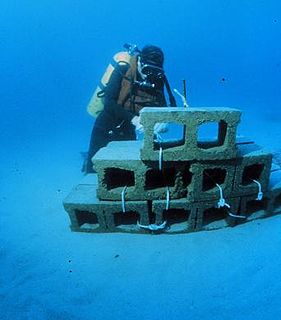 W
WAn artificial reef is a human-created underwater structure, typically built to promote marine life in areas with a generally featureless bottom, to control erosion, block ship passage, block the use of trawling nets, or improve surfing.
 W
WUSS Arkansas (BB-33) was a dreadnought battleship, the second member of the Wyoming class, built by the United States Navy. She was the third ship of the US Navy named in honor of the 25th state, and was built by the New York Shipbuilding Corporation. She was laid down in January 1910, launched in January 1911, and commissioned into the Navy in September 1912. Arkansas was armed with a main battery of twelve 12-inch (305 mm) guns and capable of a top speed of 20.5 knots.
 W
WBoscombe Surf Reef was an artificial reef built to enhance surfing conditions at Boscombe in Dorset, England.
 W
WChevron Reef, also known as Pratte's Reef, was an artificial reef constructed in 2000 in Santa Monica Bay, offshore from Dockweiler State Beach. It is the first artificial surfing reef in the United States and was the second to be built worldwide.
 W
WThe Gibraltar Artificial Reef, or simply the Gibraltar Reef, is the ongoing artificial reef project for the Mediterranean waters surrounding the British overseas territory of Gibraltar. The initiative was started in 1973 by Dr. Eric Shaw of the Helping Hand Trust.
 W
WUSS Massachusetts (BB-2) is an Indiana-class battleship and the second United States Navy ship comparable to foreign battleships of its time.
 W
WNagato (長門), named for Nagato Province, was a super-dreadnought battleship built for the Imperial Japanese Navy (IJN). Completed in 1920 as the lead ship of her class, she carried supplies for the survivors of the Great Kantō earthquake in 1923. The ship was modernized in 1934–1936 with improvements to her armor and machinery and a rebuilt superstructure in the pagoda mast style. Nagato briefly participated in the Second Sino-Japanese War in 1937 and was the flagship of Admiral Isoroku Yamamoto during the attack on Pearl Harbor. She covered the withdrawal of the attacking ships and did not participate in the attack itself.
 W
WOsborne Reef is an artificial reef off the coast of Fort Lauderdale, Florida, constructed of concrete jacks in a 50-foot (15 m) -diameter circle.
 W
WPope's Eye is the uncompleted foundation for an island fort intended to defend the entrance to Port Phillip in the state of Victoria, Australia. The undefined area of the fort, generally assessed at 4 hectares, is one of six separate areas that comprise the Port Phillip Heads Marine National Park and is a popular site for divers.
 W
WRedbird Reef is an artificial reef located in the Atlantic Ocean, off the coast of Slaughter Beach, Delaware, 16 miles (25.7 km) east of the Indian River Inlet.
 W
WRigs-to-Reefs (RTR) is the practice of converting decommissioned offshore oil and petroleum rigs into artificial reefs. Such biotic reefs have been created from oil rigs in the United States, Brunei and Malaysia. In the United States, where the practice started and is most common, Rigs-to-Reefs is a nationwide program developed by the former Minerals Management Service (MMS), now Bureau of Safety and Environmental Enforcement (BSEE), of the U.S. Department of the Interior.
 W
WUSS Saratoga (CV-3) was a Lexington-class aircraft carrier built for the United States Navy during the 1920s. Originally designed as a battlecruiser, she was converted into one of the Navy's first aircraft carriers during construction to comply with the Washington Naval Treaty of 1922. The ship entered service in 1928 and was assigned to the Pacific Fleet for her entire career. Saratoga and her sister ship, Lexington, were used to develop and refine carrier tactics in a series of annual exercises before World War II. On more than one occasion these exercises included successful surprise attacks on Pearl Harbor, Hawaii. She was one of three prewar US fleet aircraft carriers, along with Enterprise and Ranger, to serve throughout World War II.
 W
WSinking ships for wreck diving sites is the practice of scuttling old ships to produce artificial reefs suitable for wreck diving, to benefit from commercial revenues from recreational diving of the shipwreck, or to produce a diver training site.
 W
WThe 1940 Tacoma Narrows Bridge, the first Tacoma Narrows Bridge, was a suspension bridge in the U.S. state of Washington that spanned the Tacoma Narrows strait of Puget Sound between Tacoma and the Kitsap Peninsula. It opened to traffic on July 1, 1940, and dramatically collapsed into Puget Sound on November 7 the same year. The bridge's collapse has been described as "spectacular" and in subsequent decades "has attracted the attention of engineers, physicists, and mathematicians". Throughout its short existence, it was the world's third-longest suspension bridge by main span, behind the Golden Gate Bridge and the George Washington Bridge.
 W
WTod Sirod Reef, formerly known as Collier 1 Reef is an artificial reef in the Gulf of Mexico, off the coast of Collier County, Florida. It is part of a network of artificial reefs off the coast of the county.
 W
WUSS Utah (BB-31/AG-16) was the second and final member of the Florida class of dreadnought battleships. The first ship of the United States Navy named after the state of Utah, she had one sister ship, Florida. Utah was built by the New York Shipbuilding Corporation, laid down in March 1909 and launched in December of that year. She was completed in August 1911, and boasted a main battery of ten 12-inch (305 mm) guns in five twin gun turrets.
 W
WUSS Wilkes-Barre (CL-103) was a Cleveland-class light cruiser of the United States Navy that served during the last year of World War II. She was named after the city of Wilkes-Barre, Pennsylvania.